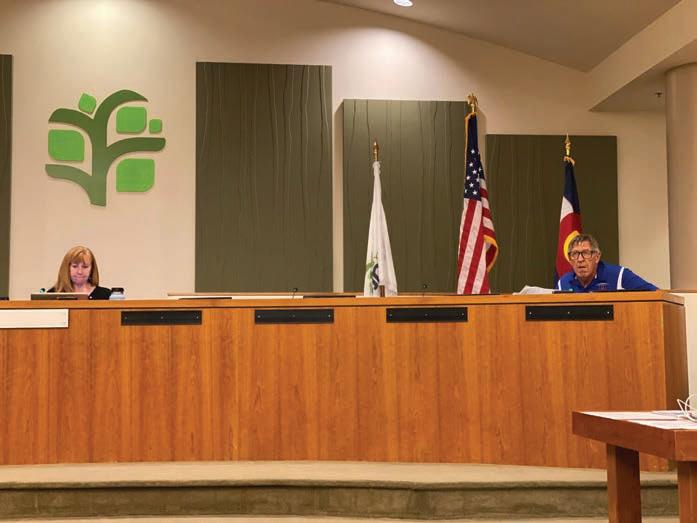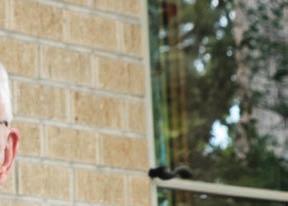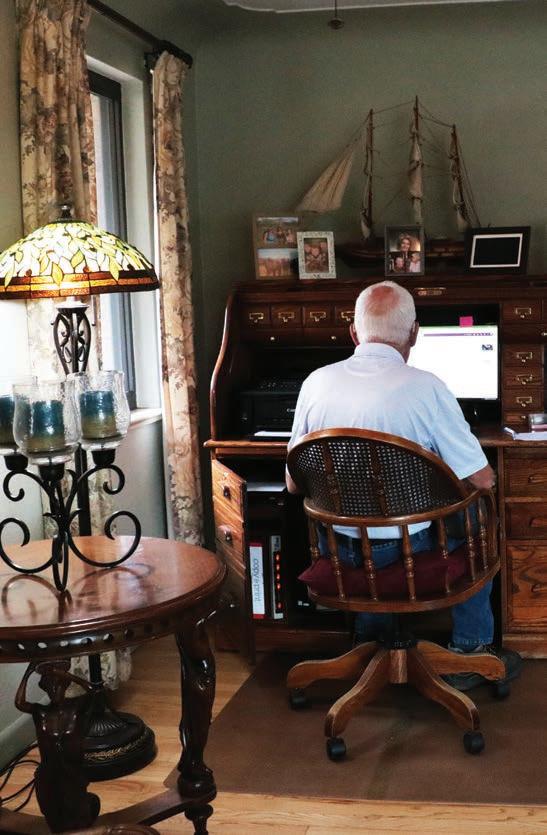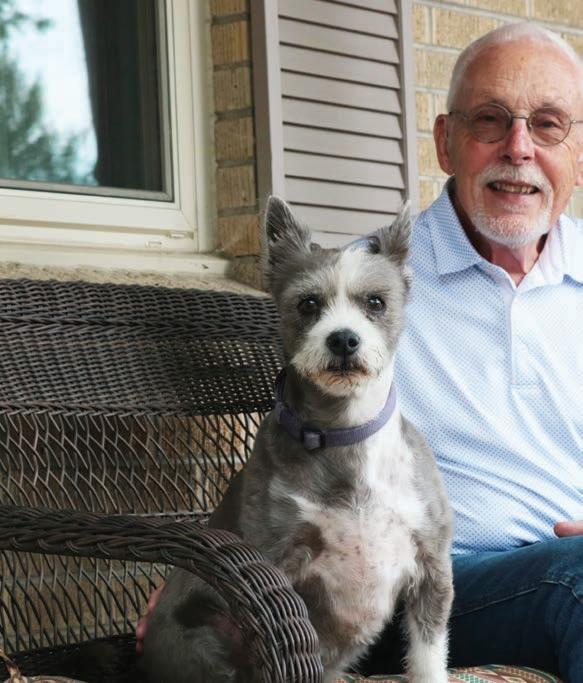
6 minute read
Residents sue city over referendum ruling
Plainti s are fighting plan for apartments at former Sam’s Automotive site
BY ELISABETH SLAY ESLAY@COLORADOCOMMUNITYMEDIA.COM
Englewood residents Davon Williams and Gary Kozacek led a civil suit in Arapahoe County District Court against the city and City Clerk Stephanie Carlile on Aug. 2.
Court documents state the two are asking the court for “judicial review of a hearing o cer order and issuance of an injunction on several grounds with regard to a referendum deemed successful on behalf of 1400+ registered voters” and themselves.
Williams and Kozacek are questioning the timeline of the initial signing and curing period of a referendum they presented to the city clerk that opposes an ordinance which approves a 395-unit residential complex.
e project was proposed by developer Embrey Partners and would sit on a lot, known as the former Sam’s Automotive site, at West Oxford Avenue and South Navajo Street.
Additionally, court documents said Williams and Kozacek are questioning the time frame of a petition protesting the referendum, the validity of notarized documents and the number of packets reviewed by the hearing o cer. e suit comes after the City Clerk’s o ce reviewed and determined only 40 out of a required 57 signatures were successfully cured on July 13. is was the nal determination that the referendum wouldn’t prevent the project from moving forward. is determination followed a public hearing held June 23, which was called after resident David Lee Carroll led a protest petition to redetermine the validity of the referendum petition presented by Williams and Kozacek, which was initially approved by the city clerk. e petition needed 1,466 signatures for the City Clerk to deem it sucient, Brown’s ruling said. be shared with their fellow community members,” she said.
Williams and Kozacek are asking for an injunction on the city to halt the project as the suit goes through the legal process and for the court to retore the orginial certi ed signature count on the referendum so it can appear on the ballot in the November election.
“Unless a court issues an order to the contrary, ling of the lawsuit has no impact on the project nor does it otherwise revive the referendum,” said Christopher Harguth, the city’s communications director.
In her ruling, hearing o cer Kristin Brown reevaluated the petition’s validity and stated only 1,409 of the 1,747 collected signatures are valid.
Williams and Kozacek submitted a letter of intent to sue the city in an Englewood City Council meeting July 17.
Arapahoe County encourages everyone to join in this observance and to recognize the important roles that parents, employers and community members play in ensuring that all children have the financial support they need to thrive. Learn more at arapahoegov.com/humanservices.

Time to hit the trails!
Lace up your sneaks for a timed 5K trail run presented by Les Schwab Tires, beginning at Tagawa Gardens and running along the Cherry Creek Regional Trail. Funds support trail maintenance and Arapahoe County Open Spaces. Includes dinner, craft beer or sports drink, and live music at the finish line. Walkers and all ages welcome!
Thursday, Aug. 24, 2023 | 5:30–7:30 p.m.
Get details: arapahoecountyeventcenter.com
SAVE THE DATE
Justice System
Racial Equity Event
Help
FROM PAGE 4
La erty said the current exhibit is at capacity for pieces, but the other two exhibits are open for more submissions.
“It is an opportunity for community members to come together to view and discuss art, to have their artwork and passion for creation on display to
She also said the exhibit is a project of the library and was inspired by previous events that featured local artists.
“It is great fun to meet new people and get to know their stories that led them to creating art and their life experiences,” she said.
To submit art pieces visit Library Art Exhibit | City of Englewood, Colorado (englewoodco.gov).

No RSVP necessary. Childcare will be provided.
Wednesday, Sept. 27 6:30–8:30 p.m.
Second Chance Center 224 Potomac St., Aurora
EVEN WITH A HOUSING VOUCHER, METRO MAN FACES ENDLESS BARRIERS TO FIND DISABLED GRANDSON A HOME

BY NINA JOSS NJOSS@COLORADOCOMMUNITYMEDIA.COM
George Vonesh drives an hour round trip each day to visit his grandson, Justin.
Justin is a kind, caring, nonjudgmental young man, says his grandfather. He keeps up on the news and likes to discuss current events. In his free time, Justin enjoys music, concerts and paranormal television shows.
He also lives with intellectual disabilities, which have impacted him since childhood. Yet, at 32 years old, Justin lives on his own in an apartment in Lafayette.
As Justin’s primary companion and caregiver, Vonesh has spent much of his life memorizing the ins and outs of programs and services that many adults with disabilities rely on — from Medicaid to food assistance programs, to housing choice vouchers and more.
“It’s taken me years to learn all this stu ,” Vonesh said.
At age 79, he is starting to worry about how he can sustainably support his grandson. e distance from Arvada — where Vonesh lives — to Lafayette is feeling more and more challenging to travel as the years go by.


He wants to move Justin closer, but for months he’s faced hurdle after hurdle. Despite all his research, paperwork, phone calls, meetings and more paperwork, Vonesh hasn’t been able to nd an apartment that will work.
e problem comes down to what’s commonly called a housing choice voucher.
Justin received a voucher in 2018, about a year and a half after applying for the rent subsidization program. He was luckier than many, as some people wait on lists for years — sometimes more than a decade — before being selected for the program that’s part of the federal Department of Housing and Urban Development, or HUD.
e program, sometimes known as Section 8, aims “to help very low-income families, the elderly and the disabled a ord decent, safe and sanitary housing,” according to HUD.
Justin is both low-income and disabled in the eyes of the government. His income was about $800 per month — less than 7% of the area median income in his county — when he applied for a voucher. is money came from a monthly stipend for people with disabilities, called Supplemental Security Income.
Since then, however, Vonesh has learned that a voucher is not a guaranteed ticket to housing.
“It’s not easy,” he said, gesturing at a pile of paperwork full of handwritten notes and math problems. “Even now, with all this homework that I have, I still am never quite sure about all the exact steps.” rough his deep dive into the program and its many intricacies, Vonesh has uncovered a system with pitfalls at every turn. Sometimes, these challenges come from administrative complexities of the program. Other times, they are rooted in discrimination.
As Vonesh has worked tirelessly to nd a home for his grandson, housing advocates have taken steps to strengthen laws meant to protect people like Justin.

A new law on this front, which goes into e ect this month, has resulted in resistance from Colorado landlords. While they concede that people with housing vouchers can struggle to nd a place, they say the problem should be addressed by making the program more economically attractive — not mandating how landlords interact with it.
Moving Justin closer Vonesh has been living in the same Arvada home for over 50 years. Since his wife passed away a few years ago, he divides his time between taking care of his dog, Jasper, and his grandson.
“Jasper in the morning, Justin in the afternoon,” he said.
Justin’s disabilities, which impact his social interactions, have made it challenging for him to make friends over the years. Vonesh said that causes Justin to be sad sometimes, making the daily visits even more important.
“If I don’t go up there, he’s just by himself,” he said.
As Vonesh gets older, the long drive is becoming more challenging.
“It’s hard on me,” he said. “I’m getting old and that tra c is dangerous … so I’d like to get him closer. Otherwise, I’m telling him, we’re just gonna have to gure out some days a week that I take o .”
But Vonesh has had little luck since he began searching for a closer apartment eight months ago. Because Justin has a voucher, moving is a complicated process that involves a staggering number of considerations.
First, prospective apartments need to qualify under a payment standard set by HUD. at means the unit, plus utilities, has to be at or under a speci c price.
Once Vonesh nds an apartment at the correct rate in a desired area, there has to be a vacancy that lines up with the end of Justin’s current lease. He also has to add time for a federally mandated inspection of the unit.
If the new apartment is in a di erent county, Vonesh would need to transfer Justin’s rental subsidy across housing authority lines. e process is possible, but it adds extra steps that take time. In a fast-paced rental market where landlords want tenants con rmed as quickly as possible, the timeline of these extra steps can complicate options.
Add those requirements to the personal desires any person may have for an apartment — like in-unit laundry or a place to sit outside — and Vonesh has a puzzle on his hands.
It is a puzzle that gets more challenging when some landlords, Vonesh says, won’t even take a glance at Justin’s application.
“I have lost count of the








